With Jan Van Eyck, we are on more conventional territory than the mad Heironymous Bosch in the portrait of hermits (see previous post). Bosch was engulfed in a millenarian contagion of madness and portrays the shift in psychology from the hermit’s temptation as a thought to the hermit’s temptation as an external object, thus giving reality to what was a matter of abstraction and conscience. Bosch gives flesh to the abstraction of diabolism. The resulting loss of control in the face of the fantastic portrays as true or real what is madness.
Van Eyck, however, was a careful and cultivated craftsman, a bourgeois in the original sense. He painted for wealthy clients — and thus becoming wealthy himself — carefully circumscribing his skills to those remunerative themes such as portraits that reflected the psychology of the time. Thus he became, even among his contemporaries, the acknowledged greatest painter of his day.
But in the St. Bavo Cathedral — i.e., Ghent — altarpiece, Van Eyck manages to insert a panel of “Holy Hermits.” It is the only place where something of life outside the polite ecclesiastical and wealthy circles of his patrons occurs, if we are not to count the frankness of his naked Eve. By the date of his painting (1430) few hermits would presumably have remained in Europe, let alone taken a prominent place in religious art, but these hermits are, after all, historical hermits, and the implications of eremitism for Van Eyck’s contemporaries would have been well nigh lost to antiquarianism. Like the giant St. Christopher who leads the saints in the adjacent panel, the altarpiece is intended to recall highlights of religious history, not to advocate a new ecclesiastical hierarchy.
The hermits look suitably gruff, now that they are safely extinct. Were it not for their brown robes, they are characteristically and simultaneously pious and menacing, emerging from a forest seclusion and coming around a bend. Behind them two angels oversee the troupe. It is a portrait of eremitism that is classical in every sense. But look carefully into their eyes, the posture of their heads and faces, their reluctant gait. One can imagine a radical simplicity in these holy hermits, especially those at the back of the troupe. They don’t want to be there, playing a role crafted by someone else. They’ve not seen the light of city or sovereign for a long time, and they are almost ready to bolt back into the forest. Or so one might imagine.
